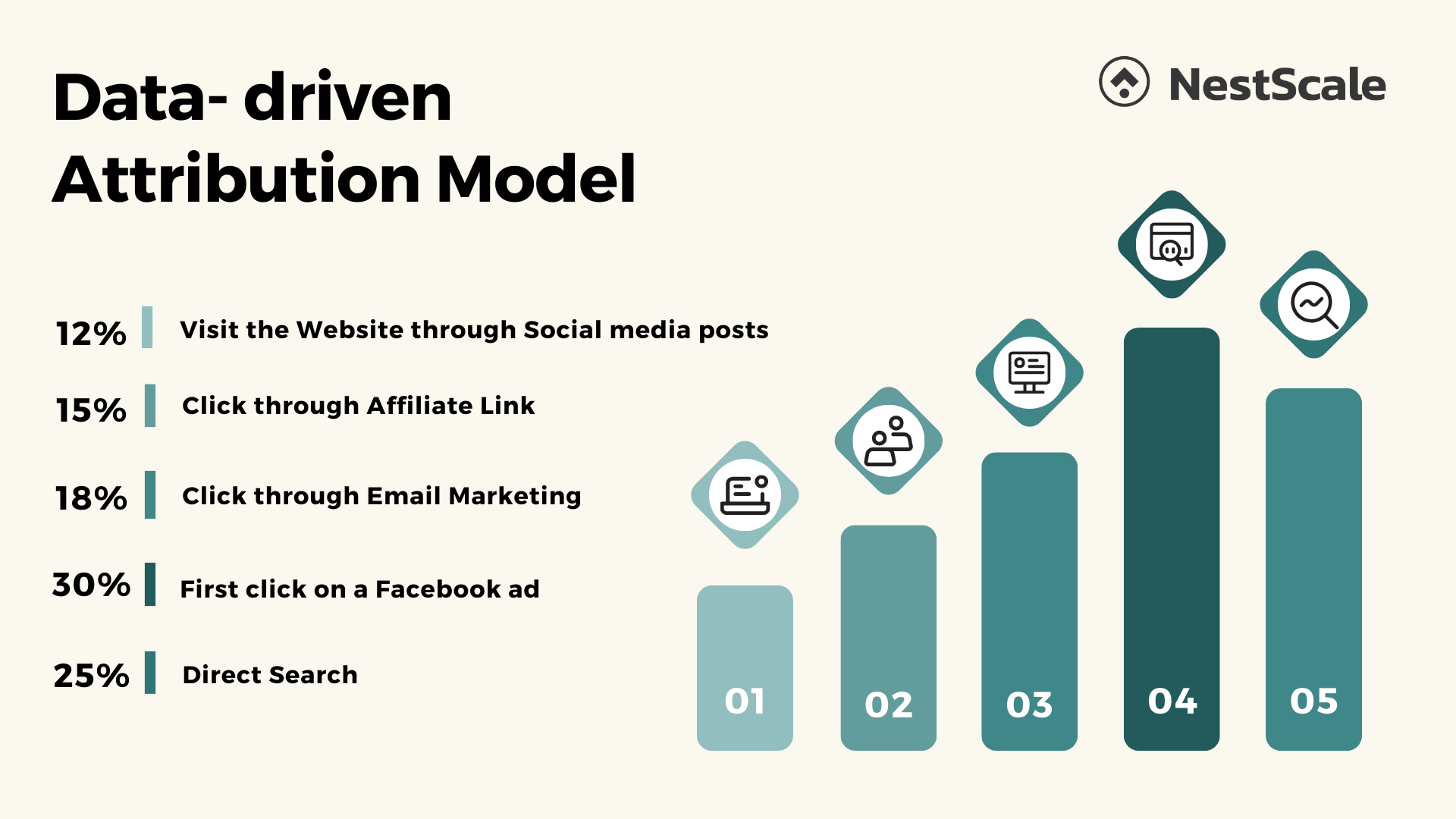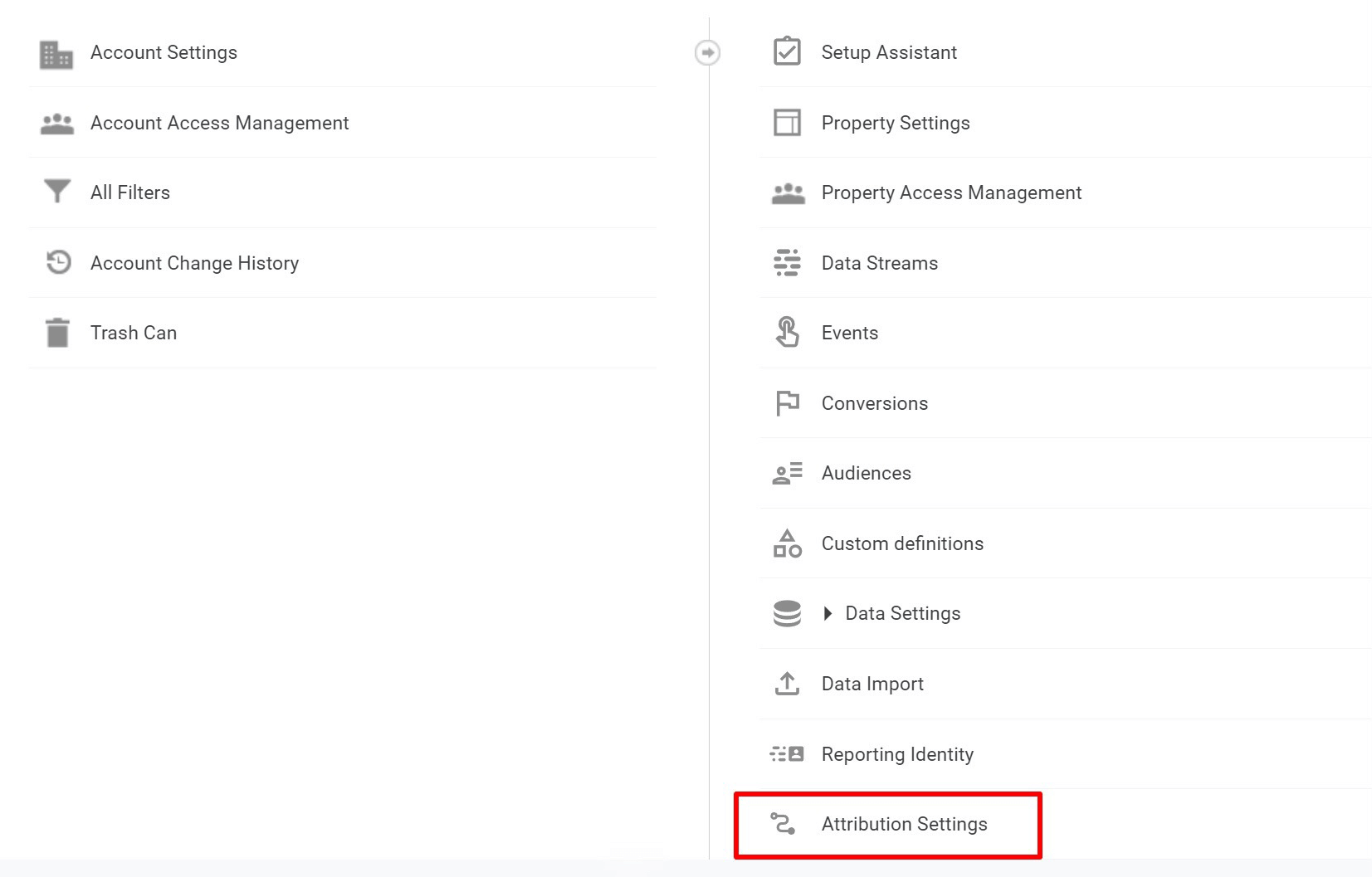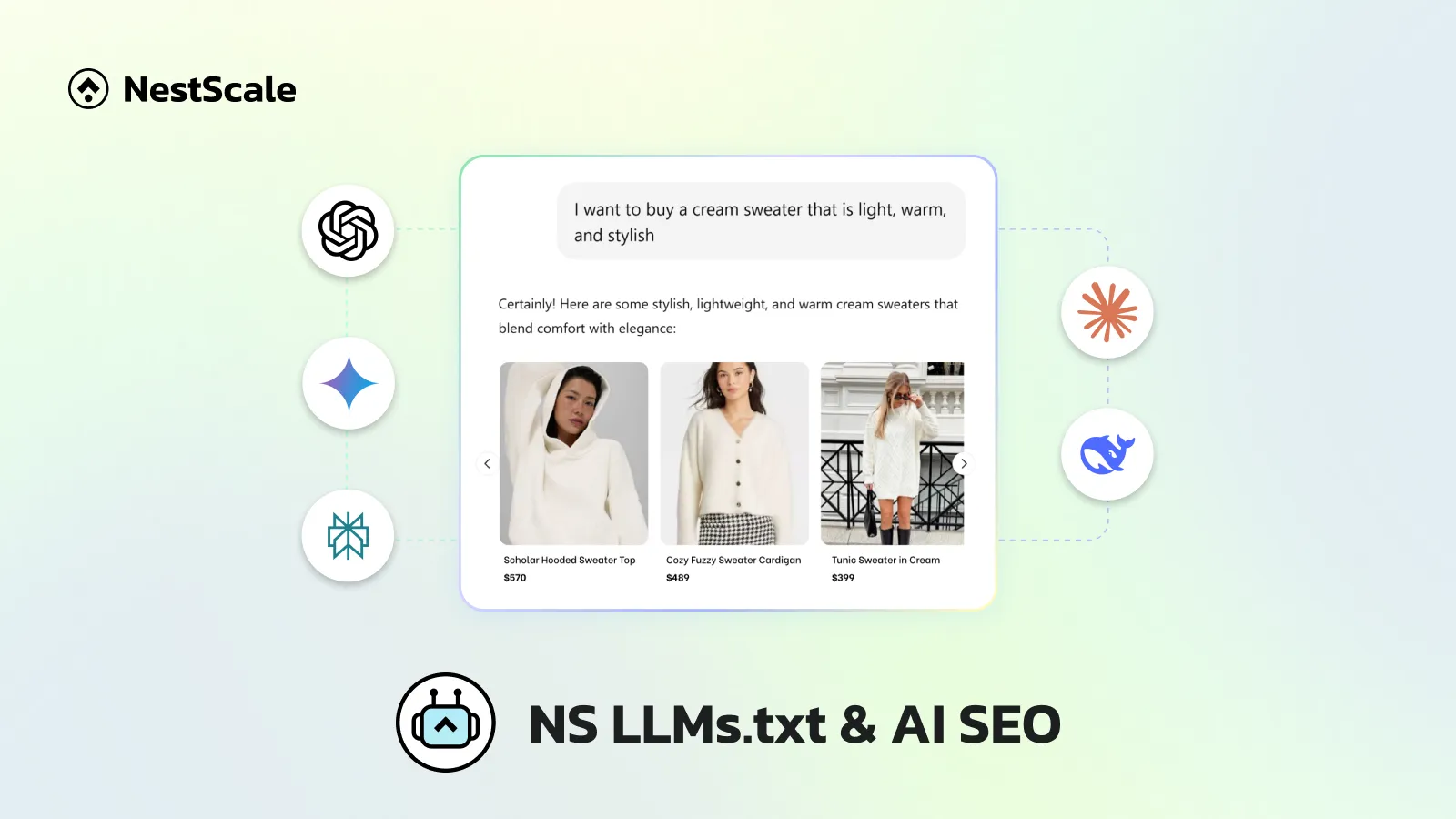If you’re on a mission to elevate your marketing game and boost your success, you’ve come to the right place. Welcome to our comprehensive guide on Data-Driven Attribution, a crucial component of marketing attribution.
In this blog, we’ll unravel the mysteries of the Data-driven Attribution model, and how it works in both Google Ads & Google Analytics 4. Get ready to gain invaluable insights and take your strategies to the next level. Let’s dive in!
What is Data-driven attribution?
Data-driven attribution sets itself apart from the marketing attribution models we’ve previously discussed. Unlike those that rely on predefined rules to allocate credit to different touchpoints in a customer’s journey, data-driven attribution uses machine learning technology. This allows it to create a customized attribution model that accurately reflects the impact of each marketing touchpoint on conversions.
How does Data-driven attribution work in general?
For example, you’re using Data-driven attribution to track your marketing activities, including Google ads or Facebook ads. The mode gives more credit to your Facebook ad, even if it’s not the first or last touchpoint in your customers’ conversion journey.
This happens because Facebook attribution models identify Facebook ads as one of the most important channels in driving conversions. Without this channel, the results wouldn’t be as strong as before.
So, how does the model make this decision? It starts by gathering data about customers’ journeys from your account, such as ads or keyword searches that your customers engage with across various channels.
Next, it dives into this data, analyzing and comparing it to understand which touchpoints are making the most positive impact on your conversions. Eventually, you’ll end up with an attribution model that’s effective and perfectly aligned with your business goals.
However, the way the model appears can vary depending on the measurement tools you use. Each platform has its own algorithm to gauge your marketing effectiveness. Two popular tools that support this type of attribution model are Google Ads and Google Analytics 4. In the next sections, we’ll dive deeper into how this smart attribution model operates on these two platforms.
Data-driven attribution in Google Ads
Google Ads is a robust advertising platform designed to help businesses showcase their products and services to a wide audience. But how can you be sure that your ad campaigns are generating the desired results? So, this is where Data-Driven Attribution comes into play!
Google Ads has integrated Data-Driven Attribution as a feature to help advertisers make informed decisions. It uses advanced algorithms to analyze data and assign value to various touchpoints, including clicks, impressions, and interactions.
How does the model work in Google Ads?
Think of Data-driven attribution in Google Ads as your very own ad expert. It dives deep into the fine print to show you what’s happening with your ads. With the support of this model within Google Ads, you can:
- Customized Attribution: Data-driven attribution in Google Ads tailors a unique attribution model to your specific advertising endeavors.
- Comprehensive Analysis: It examines your ad history comprehensively, identifying the most influential elements like keywords, ads, ad groups, and campaigns.
- Optimized Performance: Data-driven attribution empowers you to make informed decisions, helping you identify high-impact ads and enhancing bidding strategies to maximize conversions.
However, the model only considers the touchpoints that can be tracked by Google Ads. Therefore, some non-ads and other sources’ touchpoints might be neglected when measuring in this platform.
Data requirements in Google Ads
Data-driven attribution isn’t available for all types of conversions in Google Ads. For some conversion actions, the data-driven is set as the default attribution model regardless of the conversion number or interaction volume.
However, there are also conversion actions that need to meet the requirements of the conversions and interactions to use this model. Here are 2 important requirements you need to keep in mind to switch the attribution model of those conversion actions to data-driven:
- At least 300 Conversions: Each conversion action should have at least 300 conversions happening.
- 3,000 Ad Interactions: If your conversions mainly come from supported networks, like online ads, you’ll need at least 3,000 ad interactions within 30 days.
Hey, just a heads-up: If your account’s ad interactions fall below 2000 or conversions drop below 200 in 30 days, Google Ads will automatically switch to the Last-click attribution model. So, before considering switching to the data-driven attribution model, make sure you’ve got enough data to make it work effectively.
How to set up this model in Google Ads?
Step 1: Log in to your Google Ads account, click the Tools and Settings icon
Step 2: Click the Conversions drop-down in the section menu

Step 3: Choose the conversion action you want to edit, then click Edit Settings

Step 4: Select Data-driven from the “Attribution model” drop-down menu

Step 5: Click Save, then click Done.
Data-driven attribution in Google Analytics 4
As you might know, Google Analytics 4, also known as GA4, is the latest and most advanced version of the popular web analytics platform offered by Google. It’s designed to provide businesses and website owners with deeper insights into user behavior across websites and apps.
By using the data-driven attribution model in Google Analytics 4, it can leverage machine learning algorithms to determine the most influential touchpoints. This eventually helps organizations make data-informed decisions about their marketing strategies.
How does the model work in Google Analytics 4?
Data-driven Attribution in Google Analytics 4 is like having a highly skilled detective for your website’s performance. Here’s how it operates:
- In-Depth Analysis: Data-driven Attribution in Google Analytics 4 acts like an investigator, thoroughly analyzing user journeys on your website, including clicks and video interactions across platforms like Google Shopping and YouTube ads.
- Integrated Data: This tool seamlessly collaborates with other Google products such as Google Ads, Display, and Campaign Manager 360, providing a comprehensive view of your data.
Data-driven attribution serves as your analytical detective, unveiling the complete story of user interactions. It employs advanced statistical methods to credit the most influential touchpoints, offering a more precise assessment compared to traditional models.
Data requirements in Google Analytics 4
To make the most of GA4 Data-driven Attribution, there are a few data requirements that you should keep in mind:
- Data must be accurately tracked and reported in Google Analytics 4. All the tracking codes, tags, and pixels need to be set up correctly on the relevant pages and channels.
- Google suggests having around 600 to 1000 conversions per month across your conversion events to understand which touchpoints are most influential in driving those conversions.
- Google Analytics 4 needs historical data to analyze and learn from. Google recommends having at least 28 days of historical data for the best results. This helps the model identify patterns and trends in user behavior.
Following each requirement will provide you with valuable insights into your marketing efforts.
How to set up this model in Google Analytics 4?
Here are the instructions to update an existing conversion action’s attribution model to Data-driven in Google Analytics 4:
Step 1: Log in to your Google Analytics 4 account, go to the property you want, and click Admin
Step 2: Find Attribution Settings in the menu
Step 3: Pick Data-driven attribution as your main model, or go for older models like last click, first click, or linear if you prefer
Step 4: Scroll down and set your attribution window (This is the period when a touchpoint gets credit for conversions)
What are the Pros and Cons of Data-driven attribution on Google Ads & GA4?
As we can see, data-driven attribution is a great model that can be used prominently on Google Ads and GA4. It’s popular has its own reasons, as it provides users with a plethora of benefits. Let’s break these down with us:
4 Key benefits of using Data-driven attribution on Google Ads & GA4
- Clear insights: This model brings clarity by relying on data, not guesswork. It reveals which ads are genuinely driving results.
- Fair credit: Data-driven attribution spreads the credit across all interactions in a customer’s journey. This fair distribution provides a more accurate understanding of each ad’s contribution to conversions.
- Efficient budgeting: You can allocate your ad budget more efficiently because this model helps you identify ads that statistically have a higher chance of generating sales.
Besides, Google found from their study that using a Data-driven attribution model increased conversions by a lot (30% to 60%). And even better, it makes marketing cheaper (20% to 30% less money spent per conversion). This shows it’s a powerful tool that helps marketers make smart decisions.
However, it still has some drawbacks…
- Hidden modeling: Data-driven attribution doesn’t show you how it calculates credit for each channel. Google keeps the exact process behind it under wraps. So, if you like clear answers, this might not be your cup of tea.
- No credit for non-ads: When using the data-driven attribution on Google Ads, it doesn’t give any credit to non-ad touchpoints, like organic search results or email campaigns. So if there’s only one ad in the mix, it gets full credit in Google Ads, even if it didn’t do all the heavy lifting.
To improve these drawbacks, you may need a supportive tool to help you alongside. We suggest NestAds as it provides the flexibility and transparency that Google Ads and GA4 lack.
NestAds gives you full control over how credits are assigned using customizable attribution models. This allows you to track the entire customer journey, including both ad and non-ad touchpoints like organic search, emails, and social media.
Additionally, using server-side tracking, NestAds enables you to capture accurate data, even in situations where Google’s models might miss important non-ad interactions. Hence, you get a thorough view of your marketing performance and allocate your budget more effectively across all channels, whether ads or non-ads.

NestAds provides the flexibility and transparency that Google Ads and GA4 lack, giving you actionable insights that reflect the real contribution of each marketing effort.
FAQs
Should I switch to Data-driven attribution in Google Ads?
Yes, especially if you’re looking to improve the accuracy of your conversion tracking and optimize your campaigns.
Data-driven attribution uses machine learning to assign credit across all the touchpoints in the customer journey. Thus, you will have a more comprehensive understanding of which ads, keywords, and campaigns are truly contributing to conversions.
How does Data-driven attribution compare to other attribution models?
Data-driven attribution is often considered superior to traditional models like last-click attribution or first-click attribution because it accounts for the entire customer journey rather than focusing on a single touchpoint.
Yet, you still need to consider the specific needs of your business to choose the most suitable one.
What are the challenges of implementing data-driven attribution?
Some challenges of Data-driven attribution may be:
- Data quality: The accuracy of data-driven attribution depends on the quality of your data, so making sure your data is accurate and complete is a must.
- Complexity: Data-driven attribution might be complex to set up and interpret, especially for those without a strong technical background.
- Time requirement: Implementing and analyzing data-driven attribution can be time-consuming.
Is Data-driven the best attribution model for your business?
In the dynamic landscape of digital marketing, the choice to embrace Data-driven Attribution is a significant one. It’s akin to wielding a precision tool that can propel your ad campaigns to new heights.
Yet, it’s essential to acknowledge its intricacies, like the black-box nature of its modeling and the lack of credit for non-ad touchpoints. Ultimately, the decision to incorporate data-driven attribution hinges on your specific requirements and your readiness to accept a touch of ambiguity.
By delving into this advanced attribution method and weighing its pros and cons, you can make an informed choice that aligns with your marketing goals. Remember, it’s not a one-size-fits-all solution, so you can try several different marketing attribution models to optimize your digital marketing success.





























































